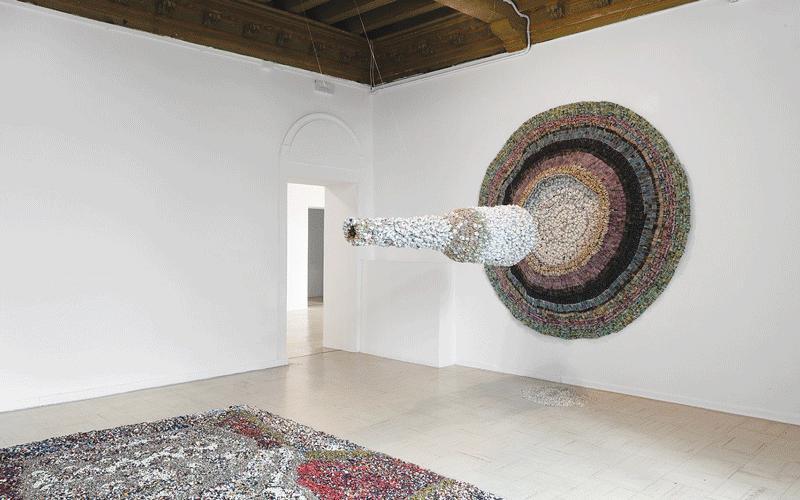Africa-Press – Zimbabwe. SENZENI Thandani, National Gallery of Zimbabwe (NGZ) curator for education and public programming, has said the recently held Artist Talk conversation at the Harare NGZ was programmed to inspire the youth, curators and prospective buyers on the beautiful works which were featured at the Zimbabwe Pavilion 60th edition of the La Biennale diVenezia in Italy.
The Zimbwean Pavillion in Italy had artworks by visual artists like Gillian Roselli (A Interfering Memories, Heritage is a Pattern), Troy Makaza (Finding Neverland 1, Mwana WaShe Murandakumwe), Sekai Machache, Moffat Takadiwa (Dudu Muduri, Delete), Victor Nyakauru (Chikwezvero, Pfimbi yeNhimbe, Ziva Kwawakabva, Maponde Anoyera) and Kombo Chapfika (Music is a Healer), whose upcycled works of imagination were curated by NGZ curator and deputy director Fadzai Veronica Muchemwa in response to the given theme Foreigners Everywhere.
Former NGZ School of Visual Arts students Makaza and Nyakauru were the only representatives and in a space of two hours, they entertained the audience through giving synopsis and narratives to their displayed artworks.
In a separate conversation, Muchemwa said the Zimbabwean Pavillion theme was Undone an Existent Crisis, which was predominantly a collection of upcycled installations and mountings prepared by the artists during COVID-19-induced lockdowns.
The artworks helped in a strong way to expose the hardships and experiences of artists during the COVID-19-induced lockdowns.
Muchemwa wrote a synopsis to Undone an Existent Crisis.
“An existential crisis: Struggle with the individuals responsibility for creating meaningless world,” it read in part.
“We are mixed in crisis of meaning, purpose and identity a painful and disorienting experience, but a terrific opportunity for growth and self-discovery.
“We want to be unfaithful to imposed ideas of time, geography and space and identity…”
The synopsis further pointed out or demanded scrutiny of interrupted sonic histories and narratives, ecologies and the new forced normal that came after an interrupted way of thinking and perception.
With this scenario, there was demand for a people to rediscover themselves and translate or interpret the world in terms better understood by everyone.
“Seeding: An undoing. A refusal. A divestment. Seeding the future and rufaro. Let us revel in chaos and find new paths that restore us,” the conclusion read.
Nyakauru, an award-winner, is a multi-media visual artist who uses found objects in both urban and rural settings to connect people to their histories and backgrounds while provoking mindsets to map our new strategies for their betterment.
His Chikwezvero (bait, charmer, enticer, inducement, fascinator, Romeo), through its emphasis on unity dictated by patches of leather, staples, steel, wood, reverts and golf balls, signifies many things in life, which include his own memoirs.
Ziva Kwawakabva and Maponde Anoyera were the other parts of his installations, with the former translated as (Remember Your Past) and the latter (Holy Mats).
“Chikwezvero means attraction and or captivation including as mentioned earlier on (bait, charmer, enticer, inducement, fascinator and Romeo),” Nyakauru said.
“My works were highly experimental and used leather, staples, rivets all bonded in unity. Leather is part of us because it is something that we live with and this piece of art is a restoration of works that should allow us to accept taking back things that we need in life, no matter what it takes.
“The pumpkin gourds artefact is symbolic of unity. Gourd resonators are used as trays, cups, shakers and or resonators for mbira.
“I urge all the underemployed and underprivileged diasporas to return home and rebuild strength on the basis of their African hospitality.”
Makaza stunned the world with his reversed or inverted symmetry Zimbabwean map, which he said was naturally formed through found objects, silicon, resin and board he brought together and called Finding Neverland 1.
He also has a pearly gate entitled Mwana WaMambo Muranda Kumwe (a king’s son is a servant in another land).
“Mwana waMambo Muranda Kumwe is a pearly gate formed from found objects like silicon, resin and board on which one has to bow down,” he said.
“Its bright colour and faint images of footprint, bowls and the mbira are an indication of beauty of entries into royal places where one has to bow down to entre. The royal gate is surrounded by pumpkins which one has to take serious caution to avoid.”
This he said in a conversation convened by Kudakwashe Chakwanda, where it was concurred that Undone was a conversation on social, economic and political unfulfilled or unsolved deliberations or aspirations.
For Makaza, Undone meant the tremendous effort exerted to undoing something so that a new art form emerges.
“My work is more societal and highlights that a community is made up of different societies. My choice of materials and detail is meant to connect to different age ranges.”
Nyakauru and Makaza accepted advice that artists should be cautious of health hazards that may result from working with found objects.
They also agreed that migrants should fully study maps of the places they intend to visit before embarking on their journeys.
Maps change as people develop their countries.
The event was attended by artists and students from the NGZ School of Visual Arts, lecturers and students from the University of Zimbabwe, First Floor Gallery and several others.
For More News And Analysis About Zimbabwe Follow Africa-Press






